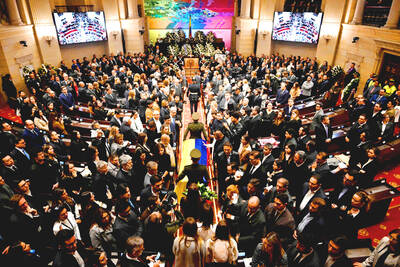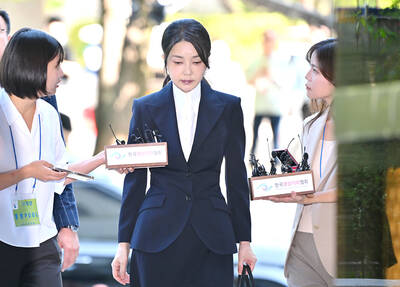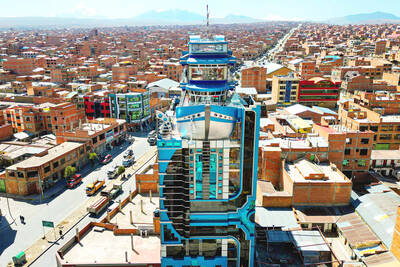For more than three decades, Cambodian villages have been home to silent killers: Former Khmer Rouge commanders who slit the throats of hundreds, sometimes thousands, of victims before dumping their bodies into shallow graves.
Filmmaker Thet Sambath spent 10 years combing the countryside trying to find those who carried out massacres so they — together with the genocidal regime’s ideological leader, Nuon Chea — could reveal the truth about one of the 20th century’s darkest chapters.
Their stories are told in the groundbreaking documentary Enemies of the People, which is playing in limited release in the US, with more theaters to be added each week into the fall, its distributor says.
At least 1.7 million people — a quarter of the population — died from execution, disease, starvation and overwork when the ultra-communist Khmer Rouge tried to turn the country into a vast, agrarian paradise from 1975 to 1979.
In the film, Soun, a former militia commander, sits beneath a tree and gazes out at what are now sparkling green rice paddies.
“I come back here to where I killed people,” he says wearily, pointing to a half dozen spots where swollen bodies used to pile up.
“I feel terrible ... My soul, my body is spinning inside. All the things I did are flashing through my mind,” Soun said.
He recalls smelling blood on his hands as he was eating rice one night: Earlier, he was looking into the eyes of a beautiful tailor who was clinging to his knees, begging to be spared. Tempted, he asked if she would live with him forever.
She quickly promised, but when he heard his own boss yell, “What are you waiting for! Hurry up!,” he thrust his knife into her and threw her on the stack.
Soun leads the 42-year-old Thet to confront other killers, who have to be convinced, slowly, to confess, and then to those who issued orders to kill ethnic minorities and others suspected of being traitors or spies for Vietnam.
Eventually it becomes clear, as they go up the chain of command, that there was probably never an “original order” from the Khmer Rouge’s inner clique to carry out massacres in the countryside.
Rather, regional chiefs, and officials directly above them were interpreting what they were hearing at an abstract political level.
The genocide occurred during the troubled times of the Cold War.
The Khmer Rouge faced internal struggles from the start. The two top leaders, Pol Pot, who died in 1998, and Nuon Chea, awaiting trial before a UN-backed war crimes tribunal, supported China. But many others were looking to their powerful neighbor to the east, Vietnam.
Nuon Chea confesses for the first time in the film that he and Pol Pot together decided to kill all party members considered “enemies of the people.” They had to be destroyed, he said defiantly, to “save the party” and “keep the rot from spreading.”
But he said he was unaware — or too busy to care — what was happening in villages and the rice fields.
The journey was a highly personal one for Thet, a senior reporter at the Phnom Penh Post newspaper.
When he was a boy, his father was stabbed to death after a public meeting organized by a Khmer Rouge cadre, where he objected to plans to seize livestock, gold and other personal property for the party.
His mother was forced to marry a member of the Khmer Rouge militia soon after, got pregnant and died in childbirth. His brother was also killed.
Thet thought that finding people who took part in some of the massacres would help him understand and heal. In the end, those who opened up to him, revealing atrocities they have kept secret from even their wives and children, also seemed to benefit.
“I want to reveal to you all the killers I know,” said Soun, who also talks at one point about drinking the bitter bile from victims’ gall bladders to gain strength.
“When we find them, and they confess the truth, I feel better,” Thet days. “I want this documentary to be shown all over the country, in the provinces, in the cities. Then the people who were killers in the regime will come forward and say, ‘Ya, I used to do that, too.’”
“Otherwise we will be gone soon, and the new generation won’t know the story,” Thet added.
In one of the most chilling scenes, Thet asks Soun to demonstrate how he killed people. A man lies on his stomach as the former militia commander, at first embarrassed, steps on his back and pulls up his head up. He takes a plastic knife and draws it across his victim’s throat.
“You hold them like this so that they cannot scream,” Soun says, slowly gaining confidence. “Sometimes I did it another way, because after I slit so many throats like this my hand ached, so I switched to stabbing the neck.”
It took years for Thet to win Nuon Chea’s full trust.
By the end, the two have formed an unquestionable bond. The war crimes court reviewing Nuon Chea’s case has asked for a copy of the film — coproduced by Thet and Briton Rob Lemkin — but he refused, saying he feels it would be a betrayal of trust.
Thet brings Soun and another man who has admitted to ordering countless killings to visit Nuon Chea so they can ask him directly why so many people had to die at their hands. They ask, too, if they themselves might end up in court.
“They are not after people like you,” Nuon Chea says in a grandfatherly manner, adding that they should not feel bad about what they did. After all, they were trying to help save the nation.
“You were the fighters, and you should be proud,” he says, adding that according to Buddhist teachings, their intentions were honorable, so they need not fear punishment now, or in their next lives.
But the tormented Soun is not convinced.
“I don’t know what I’ll be reborn as in the next life,” he says. “How many holes must I go through before I can be reborn as a human being again. I feel desperate, but I don’t know what to do.”

‘THEY KILLED HOPE’: Four presidential candidates were killed in the 1980s and 1990s, and Miguel Uribe’s mother died during a police raid to free her from Pablo Escobar Colombian presidential candidate Miguel Uribe has died two months after being shot at a campaign rally, his family said on Monday, as the attack rekindled fears of a return to the nation’s violent past. The 39-year-old conservative senator, a grandson of former Colombian president Julio Cesar Turbay (1978-1982), was shot in the head and leg on June 7 at a rally in the capital, Bogota, by a suspected 15-year-old hitman. Despite signs of progress in the past few weeks, his doctors on Saturday announced he had a new brain hemorrhage. “To break up a family is the most horrific act of violence that

HISTORIC: After the arrest of Kim Keon-hee on financial and political funding charges, the country has for the first time a former president and former first lady behind bars South Korean prosecutors yesterday raided the headquarters of the former party of jailed former South Korean president Yoon Suk-yeol to gather evidence in an election meddling case against his wife, a day after she was arrested on corruption and other charges. Former first lady Kim Keon-hee was arrested late on Tuesday on a range of charges including stock manipulation and corruption, prosecutors said. Her arrest came hours after the Seoul Central District Court reviewed prosecutors’ request for an arrest warrant against the 52-year-old. The court granted the warrant, citing the risk of tampering with evidence, after prosecutors submitted an 848-page opinion laying out

STAGNATION: Once a bastion of leftist politics, the Aymara stronghold of El Alto is showing signs of shifting right ahead of the presidential election A giant cruise ship dominates the skyline in the city of El Alto in landlocked Bolivia, a symbol of the transformation of an indigenous bastion keenly fought over in tomorrow’s presidential election. The “Titanic,” as the tallest building in the city is known, serves as the latest in a collection of uber-flamboyant neo-Andean “cholets” — a mix of chalet and “chola” or Indigenous woman — built by Bolivia’s Aymara bourgeoisie over the past two decades. Victor Choque Flores, a self-made 46-year-old businessman, forked out millions of US dollars for his “ship in a sea of bricks,” as he calls his futuristic 12-story

A man has survived clinging to the outside of an Austrian high-speed train, Austria’s state railway said on Sunday, reportedly after it left while he was having a cigarette break. The man late on Saturday grabbed onto the outside of the train at St Poelten, west of Vienna, and was later taken onboard after the train performed an emergency stop, railways spokesman Herbert Hofer said. “It is irresponsible, this kind of thing usually ends up with someone dying,” he said. “And you’re not just putting yourself in danger, if you end up under the train there’s rescuers, there’s police, fire